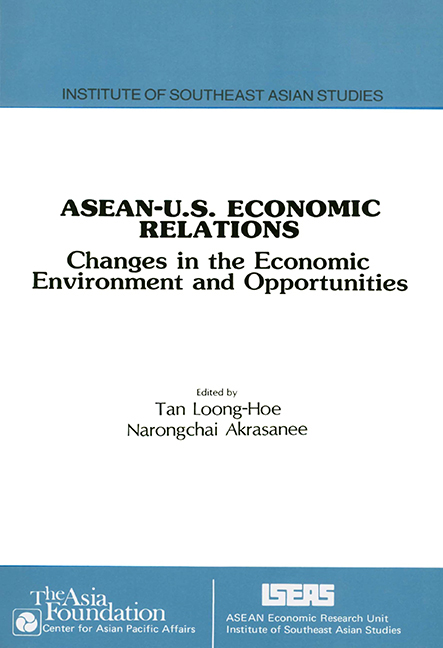Changes in the ASEAN-U.S. Economic Environment and Opportunities: An Introductory Overview
Published online by Cambridge University Press: 21 October 2015
Summary
Addressing the 20th ASEAN Ministerial Meeting on 15 June 1987 in Singapore, Singapore's Premier Lee Kuan Yew outlined the major changes ASEAN countries were undergoing against a backdrop of four Pacific powers – the United States, Japan, China, and the Soviet Union – and made two observations which are particularly pertinent to the discussion here. First, on the optimism in ASEAN's economic future, he said “sooner or later, the world economy will enter a new cycle of growth and prosperity. We would do well to restructure our economies and prepare ourselves for (his next surge of high economic activities.…” Second, with reference to the United States, Mr Lee added that it was in ASEAN's interest to have the U.S. quickly regain its competitiveness and become once again a creditor rather than a debtor nation. The challenge for the United States is to muster the political will to resolve the root causes of its huge budget and trade deficits (Straits Times, 16 June 1987).
The papers in this volume address the changes in the ASEAN-U.S. economic environment and opportunities. To explore this theme in a more focused and systematic way, the volume is divided into four parts. Part I considers the broad trends of recent economic performance of the United States and the problem of increasing protectionism. The implications and consequences of these trends on ASEAN or ASEAN-U.S. economic relations are also examined. Part II analyses the structural adjustments both in the developed country, i.e., the United States, and in the developing countries in ASEAN. It examines the comparative advantage of ASEAN countries and how they should respond to likely changes of industrial and trade policies in general, and those of the U.S. in particular. Part III provides analyses of U.S.-ASEAN trade in services, both from the U.S. and ASEAN viewpoints, and includes discussions of past experience in the light of future directions. Similarly, Part IV examines the role of private enterprise in the development of U.S.-ASEAN economic relations, with illustrations of selected American and Thai agribusiness firms operating in Thailand.
- Type
- Chapter
- Information
- ASEAN-U.S. Economic RelationsChanges in the Economic Environment and Opportunities, pp. xv - xxiiPublisher: ISEAS–Yusof Ishak InstitutePrint publication year: 1988



